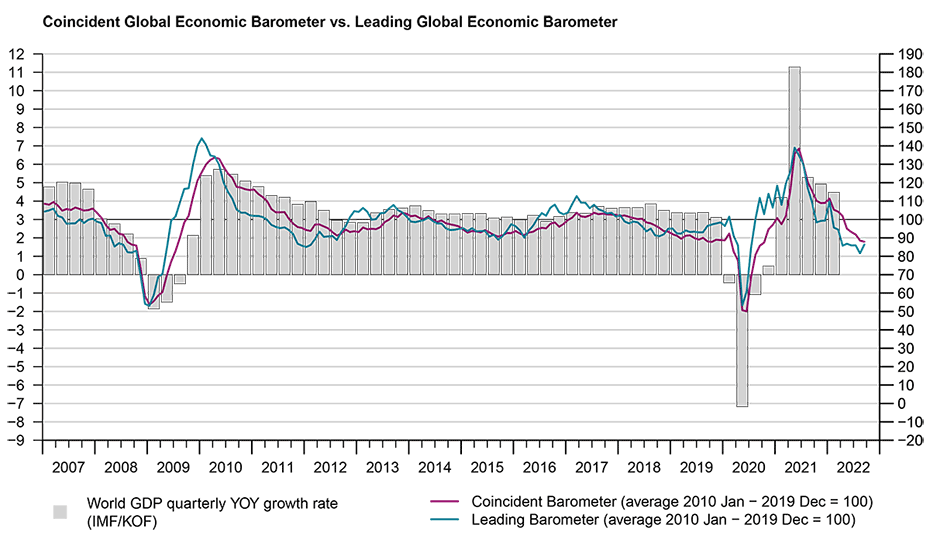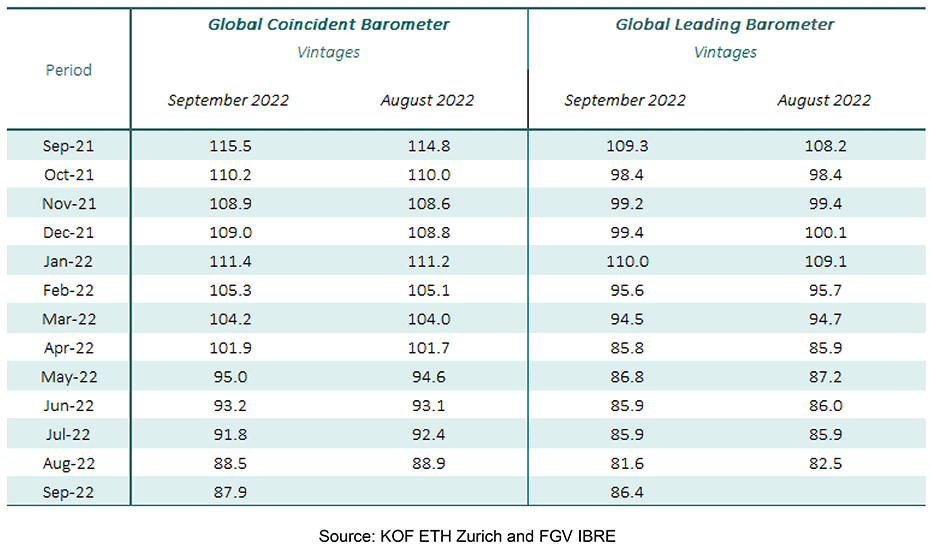Global Barometers suggest the world still faces an economic slowdown
The Global Barometers move in opposite directions in September. The Coincident Barometer falls for the eighth consecutive month while the Leading Barometer increases, but continues to fluctuate at a low level, signaling continued pessimism in the global economic growth perspective for the coming months.
In September 2022, the two Global Economic Barometers get closer after having departed from each other between February and August of this year. The Coincident Global Economic Barometer falls 0.6 points to 87.9 points and the Leading Global Economic Barometer climbs 4.8 points for the month to 86.4 points. The drop in the Coincident indicator is determined by the Asia, Pacific & Africa and Europe regions while the increase in the Leading Barometer is concentrated in the Asia, Pacific & Africa region.
“Despite the seemingly ever-increasing tensions on the European gas and energy markets, the outlook for the global economy has improved somewhat, returning to levels seen last spring. However, this is only attributable to the Asia, Pacific and Africa regions. Slightly downward assessments of the current situation still indicate that the bottom of this economic cycle has not yet been reached. When this will be the case is likely to depend heavily on political developments”, evaluates Jan-Egbert Sturm, Director of KOF Swiss Economic Institute.
““Despite the seemingly ever-increasing tensions on the European gas and energy markets, the outlook for the global economy has improved somewhat, returning to levels seen last spring."”Jan-Egbert Sturm, Director of KOF Swiss Economic Institute
Coincident Barometer – regions and sectors
In September, the Asia, Pacific & Africa and Europe regions each contribute -0.3 points to the fall, while the indicator for the Western Hemisphere remains stable. The continued tendency towards a decrease in the global indicator is partly caused by the supply restrictions related to the war in Eastern Europe and the economic slowdown in Asia, especially in China, which returned to intensifying restrictions on mobility as an auxiliary measure in the combat against the COVID-19 outbreak. The graph below illustrates the contribution of each region to the deviation of the Coincident Barometer from the historical mean of 100 points.
Among the coincident sector indicators, Services, Industry, and Trade decrease this month, while Construction and the indicator for the general state of the Economy (aggregated business and consumer evaluations) move in the opposite direction. With this result, the indicator for the general state of the Economy sustains the highest level among the sectors for the second consecutive month and Construction reduces the distance to the other sectors.
Leading Barometer – regions and sectors
The Leading Global Barometer leads the world economic growth rate cycle by three to six months on average. In September, the global indicator increases 4.8 points to 86.4 points, recovering the 4.3-point loss of the previous month. The Asia, Pacific & Africa region is the only region to contribute positively to the rise in the indicator, with 5.1 points, while Europe and the Western Hemisphere continue to move in the opposite direction, with contributions of -0.2 and –0.1 points, respectively. The Leading indicator has been fluctuating over recent months, suggesting that global growth expectations for 2022 have been encountering obstacles to the recovery of sustainable growth, such as the continuing conflict between Ukraine and Russia and the adoption of more restrictive monetary policies in various countries. Said factors have contributed to maintaining the global indicator in the adverse region.
Except for Trade, all the Leading indicator sectors rise this month. Despite the improvement, all the indicators remain far below the historical mean of 100 points, with emphasis on the negative perspectives of the Services sector, whose indicator is now 18.8 points below the neutral level. With a value of 9.6 points below average, the indicator for the general state of the Economy (aggregated business and consumer evaluations) records the highest level among the sectors for the first time since March 2021.
The Global Economic Barometers
The Global Economic Barometers are a system of indicators enabling timely analysis of global economic development. They represent a collaboration between the KOF Swiss Economic Institute of the ETH Zurich in Switzerland and Fundação Getulio Vargas (FGV), based in Rio de Janeiro, Brazil. The system consists of two composite indicators, the Coincident Barometer and the Leading Barometer. The Coincident Barometer reflects the current state of economic activity, while the Leading Barometer provides a cyclical signal roughly six months ahead of current economic developments.
The two Barometers comprise the results of economic tendency surveys conducted in more than 50 countries with the aim of achieving the broadest possible global coverage. The advantages of economic tendency surveys are that their results are usually readily available and are not substantially revised after first publication.
The Coincident Barometer includes more than 1,000 different time series, while the Leading Barometer consists of over 600 time series. Cross-correlation analysis is used to decide which individual time series are included in the barometers. This involves correlating the individual time series with a reference series. The reference series used is the year-on-year growth rate of global gross domestic product (GDP), where the individual national GDPs are aggregated at purchasing power parity to form global GDP. A time series is only included in a Barometer if it shows a sufficiently high correlation and a suitable synchronization or lead with the reference series. The time period used for this correlation analysis currently runs from January 2010 to December 2019.
The series of the two Barometers are revised each month at publication and are standardized to have a mean of 100 and a standard deviation of 10 for the 10-year period previous to the most recent observations.
The methodology is described in:
Klaus Abberger, Michael Graff, Aloisio Jr. Campelo, Anna Carolina Lemos Gouveia, Oliver Müller and Jan-Egbert Sturm (2020), The Global Economic Barometers: Composite indicators for the world economy. KOF Working Papers, vol. 471, Zurich: KOF Swiss Economic Institute, ETH Zurich, 2020.
Contact
KOF Konjunkturforschungsstelle
Leonhardstrasse 21
8092
Zürich
Switzerland

